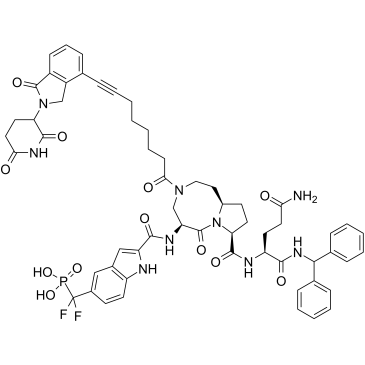SD-36 |
| Catalog No.GC61270 |
SD-36 is a potent and efficacious STAT3 PROTAC degrader (Kd=~50 nM), and demonstrates high selectivity over other STAT members. SD-36 also effectively degrades mutated STAT3 proteins in cells and suppresses the transcriptional activity of STAT3 (IC50=10 nM). SD-36 exerts robust anti-tumor activity, and achieves complete and long-lasting tumor regression in mouse tumor models. SD-36 is composed of the STAT3 inhibitor SI-109, a linker, and an analog of Cereblon ligand Lenalidomide for E3 ubiquitin ligase.
Products are for research use only. Not for human use. We do not sell to patients.

Cas No.: 2429877-44-9
Sample solution is provided at 25 µL, 10mM.
SD-36 is a potent and efficacious PROTAC STAT3 degrader (Kd=~50 nM), and demonstrates high selectivity over other STAT members. SD-36 also effectively degrades mutated STAT3 proteins in cells and suppresses the transcriptional activity of STAT3 (IC50=10 nM). SD-36 exerts robust anti-tumor activity, and achieves complete and long-lasting tumor regression in mouse tumor models. SD-36 is composed of the STAT3 inhibitor SI-109, a linker, and an analog of CRBN ligand Lenalidomide for E3 ubiquitin ligase[1].
SD-36 inhibits the growth of a subset of acute myeloid leukemia and anaplastic large-cell lymphoma cell lines by inducing cell-cycle arrest and/or apoptosis[1].SD-36 (0.005-5 μM; 4 days) demonstrates potent activity (IC50<2 μM) in MOLM-16, DEL, Karpas-299, KI-JK, SU-DHL-I, SUP-M2 cell lines[1].SD-36 (1 μM; 5 hours) completely depletes both monomeric and dimeric STAT3 protein in MOLM-16 cells[1]. Cell Viability Assay[1] Cell Line: MOLM-16, DEL, Karpas-299, KI-JK, SU-DHL-I, SUP-M2 cell lines
SD-36 (25-100 mg/kg; i.v.; weekly dosing for 4 weeks) achieves complete and long-lasting tumor regression in mice[1].SD-36 effectively inhibits tumor growth at 25 and 50 mg/kg administered on day 1, 3, and 5 per week and achieved complete tumor regression at 100 mg/kg with the same schedule in the SU-DHL-1 xenograft model[1].SD-36 at 50 mg/kg 3 times per week completely inhibits tumor growth in the SUP-M2 tumor model[1]. Animal Model: SCID female mice (MOLM-16 xenograft model)[1]
[1]. Bai L, et al. A Potent and Selective Small-Molecule Degrader of STAT3 Achieves Complete Tumor Regression In Vivo. Cancer Cell. 2019 Nov 11;36(5):498-511.e17.
Average Rating: 5 (Based on Reviews and 27 reference(s) in Google Scholar.)
GLPBIO products are for RESEARCH USE ONLY. Please make sure your review or question is research based.
Required fields are marked with *




















